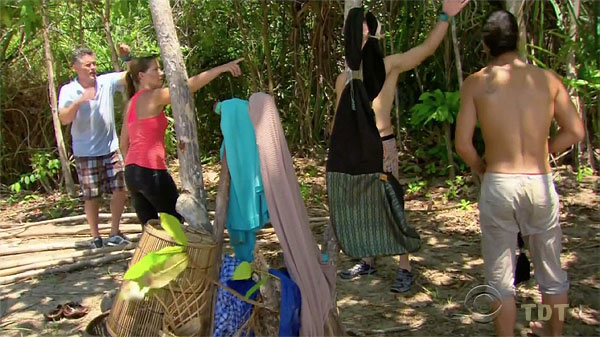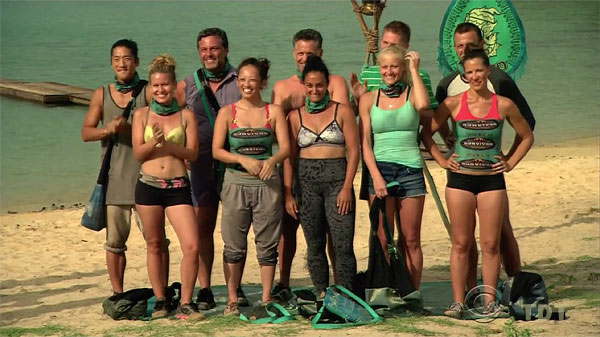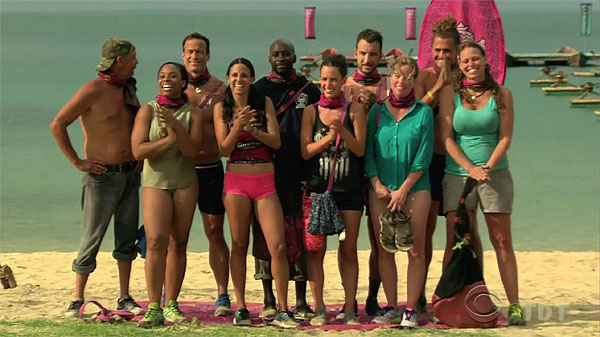

All right, here we go. Now that was a great way to begin a season of Survivor. I mean, did you see the overly dramatic way Jeff turned and gave the traditional, episode one opening? Heck, I got whiplash just watching.
Now let’s see if I can begin the first real Well, in theory… in the same overly dramatic way? A man can only dream, right?.
Let’s get down to it already. Enough of my babbling.
So if you didn’t read my preview column, or just completely forget because you got lost in my amazing predictions and witty remarks, each week this season, I’m going to use a theory often applied in communication or mass communication research to help explain strategy or how things happened or whatever.
I knew this here premiere episode would be the hardest since episode one traditionally eschews much strategy and conversation and favors backstory. But as I thought about the episode, I kept coming back to one and only one theory option: social identity theory.
As its core, social identity theory (SIT) argues two main things: first, that being part of a group with others who share similar beliefs and values is important for shaping and preserving a person’s sense of identity; and second, people want to see themselves positively and have others view them approvingly. Further, the theory posits that people become emotionally attached to membership within their group or groups.
So, before we start applying this, let me do a wee bit better job of explaining this theory in English and, more importantly, describing the other core aspect of it. Basically, what SIT says is that people consider themselves as part of a series of groups. These groups can be based on really any characteristic such as race, religion, profession, being a fan of the greatest football team ever, riding a Harley Davidson … whatever. Membership in these groups shape our identity. The other important thing to note is that we see everyone else in our group as part of the in-group, and the folks without membership as the out-group.
In-groups and out-groups on the first episode of Survivor: Cambodia? Well, let’s examine the Ta Keo tribe and start with “shelter people” and “beach people.” Oh, and also “old school” and “new school.” I think these two sets of groups overlap, with the shelter people considering themselves old school, even if they played in a recent season (hello Woo and Vytas). For the Ta Keo tribe, these groups seemed to matter a ton.

One thing to remember, is that once a person really considers themselves a part of a group, it’s very hard to leave it. They’ve really formed part of their identity around the group. This happens a lot in Survivor. How often do we watch a season and know that if someone just flipped, they’d have a much better chance of winning? Yet, most of the time, people don’t flip and they get to the end and lose and just seem happy to come in fourth place or whatever. It’s very easy for us at home to see the mistake happening way before the consequences arrive, but we’re not the contestants and we haven’t formed some of our identity around our alliance … or group.
When we do see players jump from alliance to alliance—think, of course, Rob Cesternino in Amazon or, more recently, Tony Vlachos in Cagayan— we can see from their confessionals throughout the game, they never really see themselves strongly as part of any group. This allows the flip without feeling guilty. Rightly, they see themselves as contestants on a game show looking to win. Most people aren’t wired this way, though. Numerous studies show that people simply love being part of a group, whatever the defining characteristics.
Because of this in-group/out-group dynamic within Ta Keo, it was easy for the beach folks to stick together, especially without time before tribal to really examine whether they’re group bonds remained as strong as they thought. Vytas became an easy out since they’d already bonded over his apparent smarminess or annoyingness or whatever they felt at that moment.

This, though, brings up one interesting thing that I’m going to predict. We could see throughout the episode Varner’s apparent inner turmoil about his place in the game, which group he felt connected to at the moment. We know through pre-game interviews that Jeff formed a pregame alliance with folks he betrayed with this first vote. This makes me believe he doesn’t feel strongly about either or any group, which makes me think we’ll see him flipping throughout his run on the season. This could be good strategy since various groups, like the beach people, will need a vote to make sure their plan gets enacted, but he’s going to have to form some bonds with folks because, otherwise, he may not have any votes at the end.
Now, the thing about social identity theory is that the theory is not rigid in how it sees in-groups and out-groups. People change when their circumstances, when their social cues, change. So, I bet we’re going to see these Ta Keo groups exist until a tribe split. Then we’re going to see people form new groups so they can feel connected. And they’ll typically favor the newer bonds or memberships (or alliances).
Well that’s that with the theory. Each week, I’ll use a new theory unless a previously used one makes more sense. But, I’ll end each column with a quick note about where I see each remaining contestant. So here we go with that:
Ta Keo

- 1. Spencer — I think Spencer looked a lot better than I would have thought this episode. Clearly, he had some pregame alliances. I still think, though, he’s not lasting that long. On the other tribe, we already see the beginnings of a distrust of anyone who loves strategy.
- 2. Terry — Does it surprise anyone at all that Terry found himself on the wrong side of a vote? Didn’t think so.
- 3. Abi-Maria — Holy poop. I mean, seriously? I think we heard at least 750 times how proud Abi was of herself for not blowing up at Peih-Gee over bracelet-gate. Yeah, she only flipped out to everyone else.
- 4. Woo — Someday Woo will make a strategic decision. On that day, I’ll congratulate him. At this point, even though he’s a hell of a swimmer, I blame him for taking Shane’s spot.
- 5. Peih-Gee — Like Varner, I see Peih-Gee as someone not wed to her group (or alliance) right now. I think we may see her swing back and forth throughout this game and if she can only get to the merge …
- 6. Shirin — As many of you know, I’ve been down on Shirin. She surprised me here, though. She seemed in control of the beach alliance. Now, she also showed that she’s still a wee bit socially inept and people seem to always have something to say about her interactions. This doesn’t bode well for the future.
- 7. Jeff — I’ve written enough about Jeff, but I do think he’s not destined for a middle-of-the-road ending. He feels like the kind of player that will get in trouble early now that people know hard he’s playing, or he’ll make the merge and the bigger physical threats will need to go first. I just don’t know how good it is to betray people during that first vote, though, especially when everyone seems to think these particular tribes aren’t lasting too long.
- 8. Kelley — I predicted she’d do well, but this first-episode showing was truly impressive. It’s early, but that was the clear winner’s edit of episode one, right?
- 9. Kelly — I don’t know. I voted for her to return, but I have this feeling she’s going to be a dud all season. She’s good at challenges (most of the time), but is she going to bring anything else to the table? I’m not sold.
Bayon

- 1. Joe — You have to hand it to Joe. You can do Joega™ and have everyone follow (except Keith, of course) and have some ogling you at the same time. He’s a god or something. I mean, obviously, just compare him to Vytas, who basically wanted the same thing, but nobody followed and most found him smarmy. That’s Joe. Or, as Jeremy hopes to call him for a while, Meat Shield.
- 2. Jeremy — So far, so good for my fellow Bahston native. He seems to playing a very similar game as last time with one huge exception: He’s surrounding himself with alpha males and not women so when the opposing alliance comes at his group, it may not target him.
- 3. Ciera — Did you know Ciera voted her mom out? If you didn’t, well, you learned one thing about her this episode.
- 4. Stephen — Poor Stephen. I feel like in some bizarro world, you could make the argument he’s getting the winner’s edit in an underdog shall overcome kind of way.
- 5. Tasha — Tasha likes Joe and her church told her to lie. That’s all I got. Oh, and she didn’t kill Kass. Good first episode for her, I guess.
- 6. Kimmi — At one point, Kimmi told everyone that Stephen must be looking for an idol. I didn’t think Kimmi would provide that type of insight. And she kept her cool the whole episode. If she continues playing like this, I may have underrated Kimmi.
- 7. Kass — Kass's tribe didn’t vote. Therefore Chaos Kass didn’t make an appearance. Have I mentioned that anybody who talks about themselves in the third person annoys me? Have I mentioned that anybody who talks about themselves in the third person, using some made up dumb nickname, really annoys me?
- 8. Keith — Don’t ask Keith to do no yoga. He’s got some spitting to do.
- 9. Monica — My winner pick got very little screen time this week. I feel like that may be a good thing since after I wrote my prediction, I read some pregame coverage and Monica seemed like she may play too hard too fast.
- 10. Andrew — It’s like Savage never left the Pearl Islands. Basically, he picked up right where he left off: Leading alliance of strong folks. This time, though, he’s included folks like Jeremy who have a strategic game. That could help, or really hurt, Savage. We’ll see.
OK, after about 1,800 words, I’m going to sign off now. We’ll talk next week.
 Pat Ferrucci started watching Survivor when episode two of Borneo first aired. He’s seen every episode since. Besides recapping here, he’ll be live-tweeting this season from the Mountain Time Zone. Why? Because nobody cares about the Mountain Time Zone except when they want to ski. Follow him @patferrucci for Survivor stuff and tweets about anything and everything that enters his feeble mind.
Pat Ferrucci started watching Survivor when episode two of Borneo first aired. He’s seen every episode since. Besides recapping here, he’ll be live-tweeting this season from the Mountain Time Zone. Why? Because nobody cares about the Mountain Time Zone except when they want to ski. Follow him @patferrucci for Survivor stuff and tweets about anything and everything that enters his feeble mind.
- Index of articles
- Pre-season preview
- Ep.1: Vytas, SIT down
- Ep.2: Varner teaches the Old School
- Ep.3: Tasha sets the Tribal agenda
- Ep.4: Abi continues cultivating an irrational gameplan
- Ep.5: Let's get ethical
- Ep.6: Follow the leader... or not
- Ep.7: Framing how it all went down
- Ep.8: Second Chance primed for an incredible end game
- Ep.9: Did Stephen just open or close the gate to winning?
- Eps.10-11: Construction junction, how do you function?
- Ep.12: Spiraling toward what could be an amazing end
- Ep.13: Planning behavior before the finale
- Ep.14: Wrapping up a stellar season